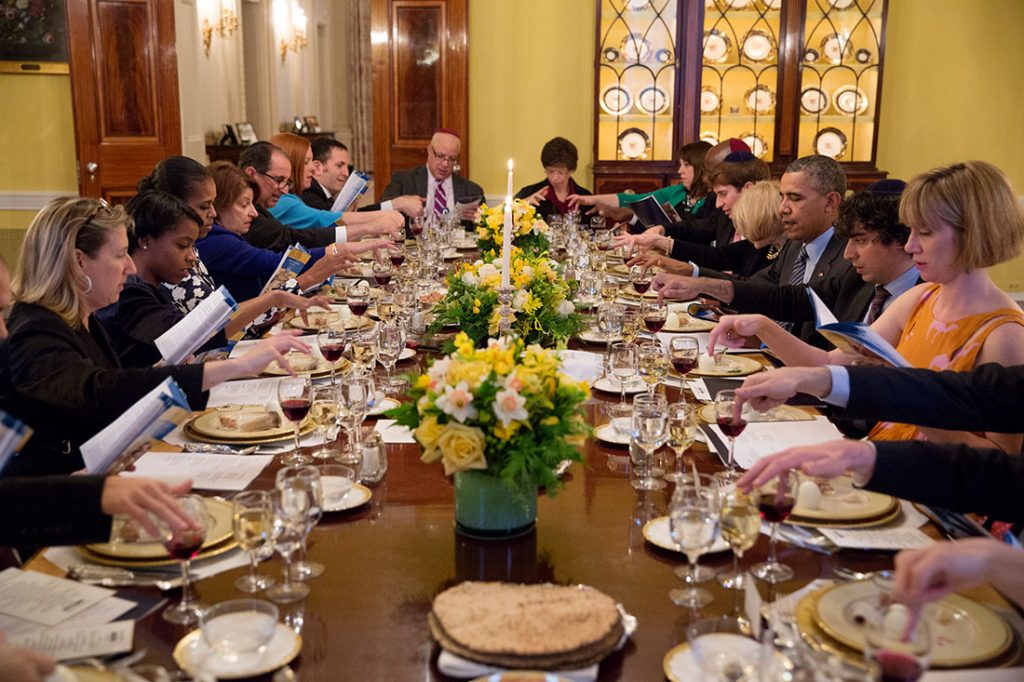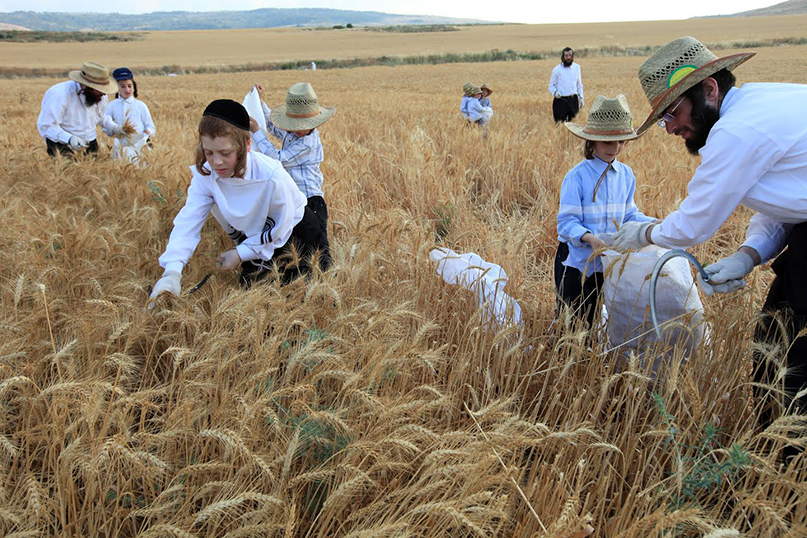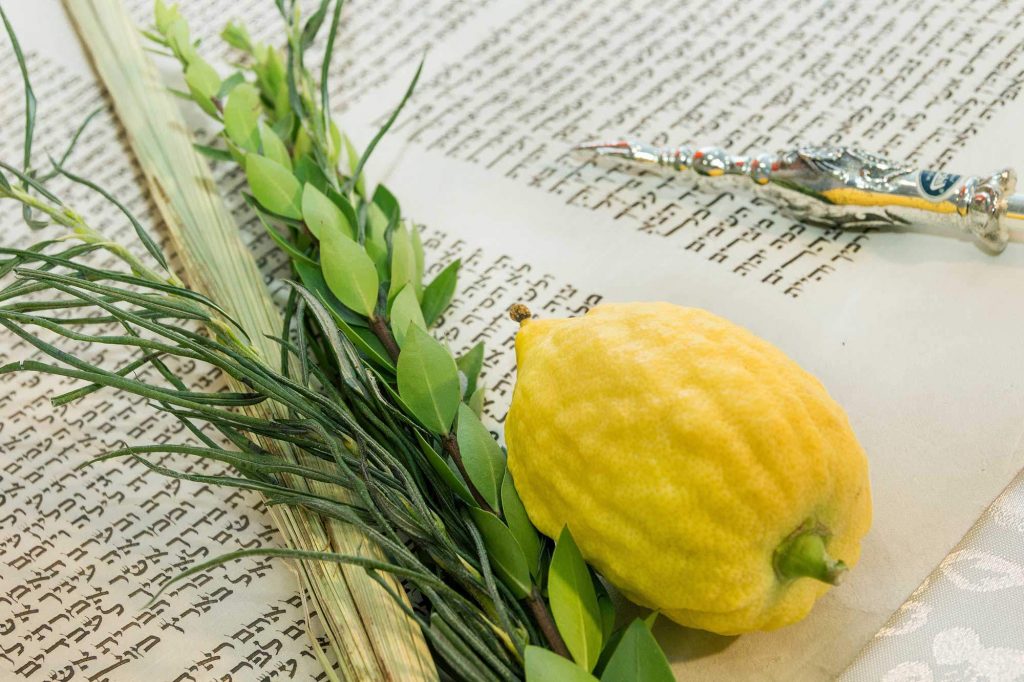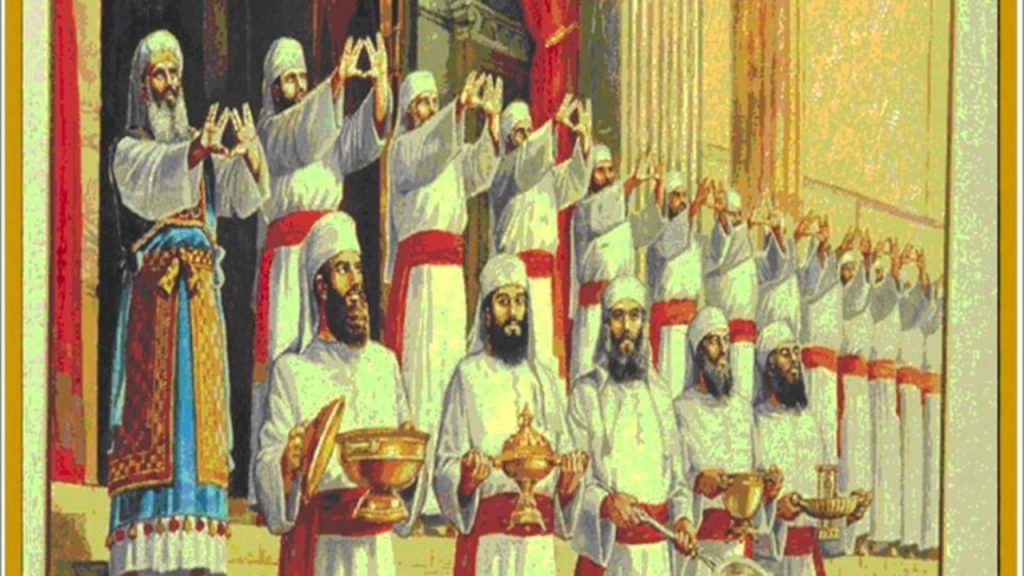In a nutshell
In Parashat Naso נָשֹׂא “lift up”, 8,580 Levite men between the ages of 30 and 50 are counted in a tally of those who will be doing the actual work of transporting the Tabernacle. The parashah addresses priestly duties, camp purification, restitution for wrongs committed, the wife accused of unfaithfulness to her husband (סוטה, sotah), the laws of the nazir, who may not drink wine, shall let his or her hair grow long, and is forbidden to become contaminated through contact with a dead body. Ahron and his descendants, the kohanim, are instructed on how to bless the people of Israel, with Birkat Hakohanim, the Priestly Blessing, and the consecration of the Tabernacle. The leaders of the twelve tribes of Israel each bring their identical gift offerings for the inauguration of the altar on a different day. Naso has 311 lines in a Torah Scroll, the largest number of letters, words, and verses of any of the 54 weekly Torah portions.
The three pilgrimages
There are three major holidays mentioned in the Torah: Passover, Shavuot and Sukkot. In biblical times during these holidays Jews from all over the ancient world of the Mediterranean were traveling to Jerusalem. In Jerusalem, they would participate in festivities and ritual worship in conjunction with the services of the kohanim (“priests”) at the Temple. These festivals were their core of a community-building experience.
For the past 2,000 years, since the cessation of the pilgrimages to the actual Temple in Jerusalem, after the Second Temple was destroyed by the Romans in 70 C.E., and until the building of the Third Temple, the actual pilgrimages are no longer obligatory upon Jews. The pilgrimage festivals continued to be celebrated primarily as synagogue-based worship services. Prayers have replaced the animal sacrifices. In Israel many people still make an effort to attend prayer services at the Western Wall, the remnant of the Temple and one of the holiest sites in Judaism, emulating the ancient pilgrimages in a way, during Passover, Shavuot and Sukkot.
Passover, Shavuot and Sukkot



We celebrate the festivals in commemoration of various events that happened to the Jewish people: Pesach– the Exodus of the Jewish people from Egypt, as well as the beginning of the new planting season, Shavuot-The Giving of the Torah and an agricultural celebration, and Sukkot-the protection of the children of Israel during their 40 years of wandering in the desert.
The Priestly Blessing
It is not a coincidence that we read the Kohanim’s commandment to bless the people with the threefold blessings: Yevarechecha (bless), Yaer (shine), and Yisa (lift), during the week of Shavuot, when Jews take it upon themselves to study Torah and practice its mitzvot. The Torah teaches us that by keeping the Torah, we receive G-d’s blessings. The Birkat HaKohanim, the Priestly Benediction, is delivered by the Kohanim, however, it is G-d’s blessing for the Children of Israel. According to Rashi, when the Kohanim bless the people in the name of G-d, it is as if G-d is blessing the people by Himself. The blessing is made up of three sentences. The Torah tells us that Aaron would lift his hands to bless the people. (Leviticus 9:22.) And to this day the Kohanim raise their hands towards the Jewish people as they deliver this ancient blessing.
יְבָרֶכְךָ יהוה, וְיִשְׁמְרֶךָ- May the LORD bless you and guard you
יָאֵר יהוה פָּנָיו אֵלֶיךָ, וִיחֻנֶּךָּ -May the LORD make His face shed light upon you and be gracious unto you
יִשָּׂא יהוה פָּנָיו אֵלֶיךָ, וְיָשֵׂם לְךָ שָׁלוֹם- May the LORD lift up His face unto you and give you peace
Yevarechecha Adonai, V’Yishmerecha
Ya’er Adonai Panav Eleycha, ViChoneka
Yisa Adonai Panav Eleycha, V’Yasem Lecha Shalom
(Number 6:24-26).
Check out YedidYah “The Priestly Blessing” Birkat Hakohanim. Music by Rabbi Yakira Yedidia https://youtu.be/YNE11QdEMN0
The 1,000 Generations
The Talmud teaches that The Torah existed 974 generations before the world was even created. In Psalms 1,000 generations are mentioned
.
“He has remembered His covenant forever, the word He commanded to a thousand generations, the covenant which He made with Abraham, and his oath to Isaac. And confirmed the same to Jacob for a law, and to Israel for an everlasting covenant.” (Psalms 105:8-10)
A Prayer of Moses, the man of G-d: “Lord, you have been our dwelling place in all generations. Before the mountains were brought forth, before you had formed the earth and the world, from everlasting to everlasting, You are God. You turn man back to dust; and say, ‘Turn back, O children of men!’ For a thousand years in your sight are but like yesterday when it is past, and like a watch in the night.” (Psalms 90:1-4)
“A thousand” is used in a verse in Ecclesiastes describing the futility of man’s aspirations: “And though he live one thousand years twice told, yet has he seen no good; do not all go to one place? All the labor of man is for his mouth, and yet the appetite is not filled.” (Ecclesiastes 6:6-7)
The 974 generations
Rabbi Shimon the Pious said: “These are the nine hundred and seventy four generations who pressed themselves forward to be created before the world was created, but were not created. The Holy One, blessed be He, arose and planted them in every generation, and it is they who are the insolent of each generation.” (Chagiga 13b-14a)
The Talmud in Shabbat also makes reference to these 974 generations:
R. Joshua b. Levi also said: “When Moses ascended on high, the ministering angels spoke before the Holy One, blessed be He: ‘Sovereign of the Universe! What business has one born of woman amongst us?’ ‘He has come to receive the Torah,’ answered He to them. Said they to Him, ‘That secret treasure, which has been hidden by Thee for nine hundred and seventy-four generations before the world was created.’” (Shabbat 88b)
The 26 generations
26 generations after the creation of the world and the first man and women, Adam and Eve, the written as well as the oral Torah were delivered to the people of Israel through Mosheh Rabbeinu. Rabbi Joshua ben Levi said: “To what do these twenty-six ‘Give thanks’ correspond? To the twenty-six generations which the Holy One, blessed be He, created in His world; though He did not give them the Torah, He sustained them by His love.” (P’sachim 118a)
1000-974 = 26 and that in all probability these 26 generations are the 26 generations from Adam to Moses when the Torah was revealed. Happy Shavuot . Loving thoughts and prayers to my beloved homeland, Israel, praying for peace in the middle east.

18 Mitzvot in Parashat Nasso
- To send the impure from the Temple Num. 5:2
- Impure people must not enter the Temple Num. 5:3
- To repent and confess wrongdoings Num. 5:7
- Not to put oil on her meal offering (as usual) Num. 5:15
- Not to put frankincense on her meal offering (as usual) Num. 5:15
- To fulfill the laws of the Sotah Num. 5:30
- He must not drink wine, wine mixtures, or wine vinegar Num. 6:3
- He must not eat fresh grapes Num. 6:3
- He must not eat raisins Num. 6:3
- He must not eat grape seeds Num. 6:4
- He must not eat grape skins Num. 6:4
- The Nazir must let his hair grow Num. 6:5
- He must not cut his hair Num. 6:5
- He must not be under the same roof as a corpse Num. 6:6
- He must not come into contact with the dead Num. 6:7
- He must shave his head after bringing sacrifices upon completion of his Nazirite period Num. 6:9
- The Kohanim must bless the Jewish nation daily Num. 6:23
- The Levites must transport the ark on their shoulders Num. 7:9
The 613 Mitzvot
In The Torah there are 613 commandments, mitzvot, also known as the Law of Moses (תרי״ג מצוות, taryag mitzvot). The 613 mitzvot are first recorded in the 3rd century CE, when Rabbi Simlai mentioned it in a sermon that is recorded in Talmud Makkot 23b.
The 613 commandments include 248 “positive commandments”, to perform an act (mitzvot aseh), and 365 “negative commandments”, to abstain from certain acts (mitzvot lo taaseh). The negative commandments number 365, which coincides with the number of days in the solar year, and the positive commandments number 248, a number ascribed to the number of bones and main organs in the human body.
Though the number 613 is mentioned in the Talmud, its real significance increased in later medieval rabbinic literature, including many works listing or arranged by the mitzvot. The most famous of these was an enumeration of the 613 commandments by Maimonides, The Rambam.
Many of the mitzvot cannot be observed now, following the destruction of the Second Temple, although they still retain religious significance. According to one standard reckoning, there are 77 positive and 194 negative commandments that can be observed today, of which there are 26 commands that apply only within the Land of Israel. Furthermore, there are some time-related commandments from which women are exempt (examples include shofar, sukkah, lulav, tzitzit and tefillin). Some depend on the special status of a person in Judaism (such as kohanim), while others apply only to men or only to women.
according to Rambam Organized by Parshah. based on Wikipedia and http://www.vaadrv.org/rambam613mitzvot.asp ONE BIG IMPORTANT NOTE WHEN USING THIS LISTING: This listing is not all inclusive. Rambam may site multiple sources for a mitzvah is his works but this list currently only gives one source for each mitzvah.

Check out YedidYah Psalm 96 “Yiram Hayam” Music by Rabbi Yakira Yedidia https://youtu.be/aTBD4i9nvXw
The Priestly Blessing
יְבָרֶכְךָ יהוה, וְיִשְׁמְרֶךָ- May the LORD bless you and guard you
יָאֵר יהוה פָּנָיו אֵלֶיךָ, וִיחֻנֶּךָּ -May the LORD make His face shed light upon you and be gracious unto you
יִשָּׂא יהוה פָּנָיו אֵלֶיךָ, וְיָשֵׂם לְךָ שָׁלוֹם- May the LORD lift up His face unto you and give you peace
Check out YedidYah “The Priestly Blessing” Birkat Hakohanim. Music by Rabbi Yakira Yedidia https://youtu.be/YNE11QdEMN0

This blog article was inspired by chabbad.org, Sefaria.org, Wikipedia.org, kabbalahsecrets.com

